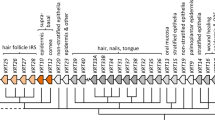Abstract
The DNA sequences encoding β-keratin have been obtained from Marsh Mugger (Crocodylus palustris) and Orinoco Crocodiles (Crocodylus intermedius). Through the deduced amino acid sequence, these proteins are rich in glycine, proline and serine. The central region of the proteins are composed of two beta-folded regions and show a high degree of identity with β-keratins of aves and squamates. This central part is thought to be the site of polymerization to build the framework of β-keratin filaments. It is believed that the β-keratins in reptiles and birds share a common ancestry. Near the C-terminal, these β-keratins contain a peptide rich in glycine-X and glycine-X-X, and the distinctive feature of the region is some 12-amino acid repeats, which are similar to the 13-amino acid repeats in chick scale keratin but absent from avian feather keratin. From our phylogenetic analysis, the β-keratins in crocodile have a closer relationship with avian keratins than the other keratins in reptiles.




Similar content being viewed by others
References
Sawyer RH, Knapp LW (2003) Avian skin development and the evolutionary origin of feathers. J Exp Zool B Mol Dev Evol 298:57–72
Molloy PL, Powell BC, Gregg K et al (1982) Organisation of feather keratin genes in the chick genome. Nucleic Acids Res 10:6007–6021. doi:10.1093/nar/10.19.6007
Gregg K, Wilton SD, Parry DAD et al (1984) A comparison of genomic coding sequences for feather and scale keratins: structural and evolutionary implications. EMBO J 3:175–178
Alibardi L, Sawyer RH (2002) Immunocytochemical analysis of beta keratins in the epidermis of chelonians, lepidosaurians, and archosaurians. J Exp Zool 293:27–38. doi:10.1002/jez.10145
Alibardi L (2004) Formation of the corneum layer in the epidermis of the tuatara (Sphenodon punctarus, Sphenodontida, Lepidosauria, Repiolia). Zoology 107:275–287. doi:10.1016/j.zool.2004.06.002
Alibardi L, Toni M (2006) Distribution and characterization of keratins in the epidermis of the Tuatara (Sphenodon punctatus; Lepidosauria, Reptilia). Zool Sci 23:801–807. doi:10.2108/zsj.23.801
Toni M, Alibard L (2007) Characterization of beta-keratins in lizard epidermis: electrophoresis, immunocytochemical and in situ-hybridization study. Tissue Cell 39:1–11. doi:10.1016/j.tice.2006.10.001
Alibardi L, Toni M (2006) Cytochemical, biochemical and molecular aspects of the process of keratinization in the epidermis of reptilian scales. Prog Histochem Cytochem 40:73–134
Alibardi L (2003) Immunocytochemistry and keratinization in the epidermis of crocodilians. Zool Stud 42(2):346–435
Sawyer RH, Glenn T, French JO et al (2000) The expression of beta (β) keratins in the epidermal appendages of reptiles and birds. Am Zool 40:530–539. doi:10.1668/0003-1569(2000)040[0530:TEOBKI]2.0.CO;2
Alibardi L, Dalla Valle L, Toffolo V et al (2006) Scale keratin-associated protein (β-keratin) in lizard epidermis reveals amino acid regions homologous with hard keratins of birds and mammals. Anat Rec 288A:734–752. doi:10.1002/ar.a.20342
Dalla Valle L, Toffolo V, Belvedere P et al (2005) Isolation of a mRNA encoding a glycine-proline-rich β-keratin expressed in the regenerating epidermis of lizard. Dev Dyn 234:934–947. doi:10.1002/dvdy.20581
Dalla Valle L, Nardi A, Toffolo V et al (2006) Cloning and characterization of scale β-keratins in the differentiating epidermis of Geckoes show they are glycine-proline-serine-rich proteins with a central motif homologous to avian beta-keratins. Dev Dyn 236:374–388. doi:10.1002/dvdy.21022
Dalla Valle L, Nardi A, Gelmi C, Toni M, Emera D, Alibardi L (2009). β-Keratins of the crocodilian epidermis: composition, structure, and phylogenetic relationships. J Exp Zool B Mol Dev Evol 312(1):42–57. doi: 10.1002/jez.b.21241
Sambrook J, Russell DW (2001) Molecular Cloning: a laboratory manual, 3rd edn. Cold Spring harbor Laboratory, Cold Spring Harbor, NY
Rychlik W, Rychlik P (2000) Oligo primer analysis software. Version6.01. Cascade, Colorado: molecular Biology Insights, Inc
Thompson JD, Gibson TJ, Plewniak F et al (1997) The CLUSTAL_X windows interface: flexible strategies for multiple sequence alignment aided by quality analysis tools. Nucleic Acids Res 25:4876–4882. doi:10.1093/nar/25.24.4876
Kumar S, Tamura K, Jakobsen IB, Nei M, MEGA (2001) Molecular evolutionary genetics analysis software. Arizona State University, Tempe, AZ
Hearle JWS (2000) A critical review of the structural mechanics of wool and hair fibres. Int J Biol Macromol 27(2):123–138
Frasera RDB, Parry David AD (2006) Fibrous protein structure The three-dimensional structure of trichocyte (hard α-) keratin intermediate filaments: the nature of the repeating unit. J Struct Biol 155(2):375–378
Alibardi L, Toni M, Dalla Valle L (2007) Hard cornification in reptilian epidermis in comparison to cornification in mammalian epidermis. Experimental D 16(12):961–976. doi:10.1111/j.1600-0625.2007.00609.x
Fraser RD, Parry DA (1996) The molecular structure of reptilian keratin. Int J Biol Macromol 19:207–211. doi:10.1016/0141-8130(96)01129-4
Acknowledgments
This work was financially supported by the National Natural Science Foundation of China (NSFC, no. 30770312 and30470244), the Foundation for Leader of Scholarship in Anhui and the Key Laboratory of Biotic Environment and Ecological Safety in Anhui Province.
Author information
Authors and Affiliations
Corresponding author
Rights and permissions
About this article
Cite this article
Ye, C., Wu, X., Yan, P. et al. β-Keratins in crocodiles reveal amino acid homology with avian keratins. Mol Biol Rep 37, 1169–1174 (2010). https://doi.org/10.1007/s11033-009-9480-z
Received:
Accepted:
Published:
Issue Date:
DOI: https://doi.org/10.1007/s11033-009-9480-z




